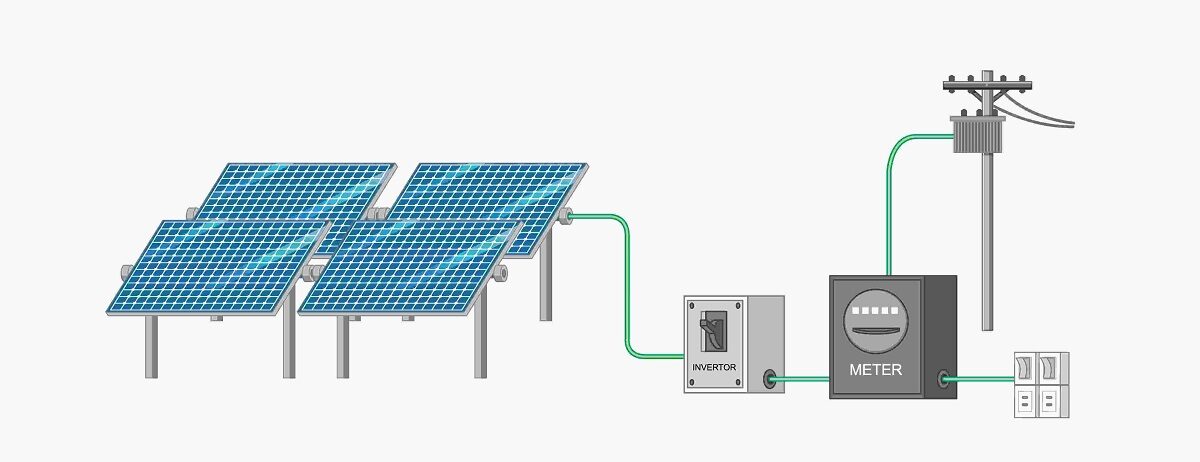What is a Solar Inverter and How Does it Work? Types and Benefits
In a solar energy system, solar panels provide power while the inverter acts as the brain, working in harmony to maximize electricity production. While solar panels are commonly recognized, the importance of solar inverters should not be underestimated. They play a crucial role in converting solar energy into usable electricity for your home. One can easily say that solar inverters play a vital role in harnessing solar power effectively. In this article, let’s explore the functions and workings of solar inverters, their importance, and the associated costs, providing a comprehensive understanding of these key components.
What is a Solar Inverter?
A solar inverter is an electrical device that converts the direct current (DC) output of a solar panel into usable alternating current (AC). It is an essential component in solar power systems, whether connected to the electrical grid or operating off-grid. In a photovoltaic (PV) system, the inverter plays a crucial role as part of the balance of system (BOS), enabling the utilization of AC-powered devices. It performs functions such as maximum power point tracking (MPPT) to optimize energy production from the PV arrays and protects against anti-islanding.
When setting up a solar system for a home, the selection and proper installation of the inverter are of utmost importance. Therefore, the inverter holds significant value as a vital device in the overall solar power system.
How does a Solar Inverter work?
Even though solar panels generate DC electricity, our household works on AC electricity. Therefore, the need for solar inverters to convert DC energy into useful electricity. This conversion is essential because most household appliances and electrical grids operate on AC power.
The process of this conversion involves certain steps:
1. The solar panel absorbs sunlight and generates DC electricity.
2. This DC power is fed into the solar inverter.
3. Within the inverter, there are power transistors and capacitors, which help to transform the DC power into AC power.
4. In situations of excess electricity production, the PV inverter allows the surplus power to be fed back into the grid.
5. In cases where the solar panels generate insufficient power to meet the entire home’s energy needs, the inverter combines solar power with grid power to fulfill the requirements.
6. During nighttime when solar panels do not produce electricity, the home may rely entirely on grid power, or the inverter can blend grid power with energy stored in solar batteries.
7. The grid-tie inverter is responsible for ensuring a seamless transition between these scenarios, ensuring the home receives sufficient power without any noticeable changes.

By facilitating the conversion process and optimizing energy output, solar inverters play a vital role in harnessing the full potential of solar power systems.
Types of Solar Inverter
There is a wide variety of types of solar inverters available in the market. Let’s take a closer look at some of the most commonly used:
1. String Inverters: String inverters are the most common type of solar inverter used in residential and commercial installations. They connect multiple solar panels in series, forming a string. The DC power generated by the panels is fed into the string inverter, which converts it into AC power for immediate use.
2. Microinverters: Microinverters are installed on individual solar panels, offering greater flexibility and efficiency compared to string inverters. Each microinverter operates independently, which enables optimal energy production even if one panel is shaded or underperforming.
3. Power Optimizers: Power optimizers represent a middle ground between string inverters and microinverters. Similar to string inverters, the electricity generated by the panels is directed to a central inverter. However, power optimizers are situated near individual panels, akin to microinverters.
4. Hybrid Inverter: Hybrid inverters are designed for systems that combine solar power with energy storage, such as solar batteries. These inverters not only convert DC power to AC power but also manage the charging and discharging of the solar battery system. They allow for greater flexibility and control over the utilization of solar energy and stored power.
5. Grid Tie Inverter: Grid tie inverters are used in grid-connected solar systems. They convert DC power from the solar panels into AC power that is synchronized with the electrical grid. These inverters ensure that the solar system can seamlessly feed excess power into the grid and draw power from the grid when needed.
Each type of solar inverter offers its own set of advantages and considerations. The solar power inverters your solar installation company will use depends on factors such as system size, shading conditions, budget, and specific requirements of the solar installation.

Benefits of a Solar Inverter
Several benefits are offered by solar inverters. Some of the key advantages are:
- Energy Conversion: Solar inverters convert the DC electricity generated by solar panels into AC electricity, which is the standard form used in homes and businesses.
- Grid Compatibility: Solar inverters enable seamless integration with the electrical grid, allowing excess energy to be fed back into the grid. This promotes grid stability and reduces reliance on non-renewable energy sources.
- Real-time Monitoring: Many solar inverters come equipped with monitoring systems that provide real-time data on energy production. This helps to track system performance, identify issues, and optimize energy usage.
- Safety Features: Solar inverters include safety mechanisms such as ground fault protection and insulation monitoring to ensure safe operation and reduce the risk of electrical hazards.
- Compatibility with Energy Storage: Solar inverters can be used with solar batteries to store excess energy for later use, providing energy independence.
- Environmental Benefits: Solar energy mitigates the greenhouse effect and helps combat climate change by reducing abnormal weather patterns.
- Cost Savings: Utilizing solar products leads to cost savings by significantly lowering electricity bills.
- Easy Installation: Solar inverters are easy to install and more cost-effective compared to generators.
These benefits make solar inverters essential components of a solar power system, enhancing energy efficiency, grid integration, safety, and sustainability.
Conclusion
In summary, solar inverters are crucial components within a solar power system. They play a vital role in converting DC electricity into AC electricity, maximizing energy efficiency, enabling integration with the electrical grid, and ensuring the safe operation of the system. With various types available, solar inverters offer a wide range of benefits for harnessing clean and renewable solar energy. making them indispensable in the transition toward a sustainable future.
FAQs
A solar inverter can operate independently without the need for batteries. It converts the DC electricity from solar panels into usable AC electricity, which can be immediately utilized in your home or fed back into the grid.
The lifespan of an inverter ranges from 10 to 20 years. However, this can vary depending on factors such as quality, usage, maintenance, and environmental conditions. Regular maintenance and proper installation can help increase its lifespan.
Yes, solar inverters require regular maintenance to ensure optimal performance. This includes cleaning the unit, inspecting for any issues, and checking connections. Wipe it free of any accumulating dust, debris, and cobwebs on a regular basis.
The inverter of a solar system can be upgraded to accommodate higher power output. It is the central component of the system, and if there is an increase in the number of solar panels, an inverter upgrade is necessary.
As solar power systems involve complex electrical connections, it is recommended to hire a professional solar installer to install a solar inverter. A professional installer will ensure proper installation, compliance with regulations, and optimal system performance.

Ileen Kaur (Author)
Ileen Kaur is an exceptional content writer, bringing her expertise and creativity to the digital realm. With a passion for storytelling and a knack for crafting compelling narratives, she has the power to captivate audiences and leave a lasting impression.
